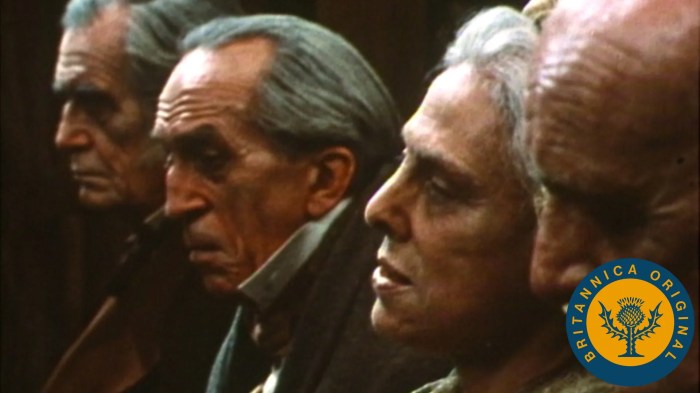Symbols in dr heidegger’s experiment – Symbols in Dr. Heidegger’s Experiment emerge as a tapestry of profound meanings, inviting readers to delve into a realm of psychological and philosophical exploration. Through Hawthorne’s masterful storytelling, these symbols become a lens through which we examine the human condition, the passage of time, and the moral consequences of clinging to the past.
From the ethereal rose-window to the enigmatic liquid, each element in this narrative carries symbolic weight, enriching the story’s themes and enhancing its impact on the reader.
Symbolism in “Dr. Heidegger’s Experiment”

Nathaniel Hawthorne’s “Dr. Heidegger’s Experiment” is a tale of regret and the desire to recapture lost youth. The story is rich in symbolism, which helps to convey the themes and messages of the narrative. Some of the most important symbols in the story include the rose-window, the mysterious liquid, and the characters’ transformations.
The Rose-Window, Symbols in dr heidegger’s experiment
The rose-window is a stained-glass window that is located in the parlor of Dr. Heidegger’s house. The window depicts a scene from the Bible in which the disciples are gathered around the table at the Last Supper. The rose-window is a symbol of the passage of time and the inevitability of death.
The disciples are all young men, but they are all destined to grow old and die. The rose-window is a reminder that even the most beautiful and vibrant things must eventually fade away.
The Mysterious Liquid
The mysterious liquid that Dr. Heidegger gives to his guests is a symbol of the elixir of life. The liquid is said to have the power to restore youth to the elderly. The guests are all eager to drink the liquid, but they are also afraid of the consequences.
They know that the liquid is dangerous, and they are not sure if they are willing to pay the price of eternal youth. The mysterious liquid is a symbol of the temptation of immortality. It is a tempting offer, but it is also a dangerous one.
The Characters’ Transformations
The characters’ transformations are a symbol of the dangers of trying to recapture lost youth. When the guests drink the mysterious liquid, they are transformed into their younger selves. However, they soon realize that they are not truly happy. They are still haunted by the memories of their past, and they are not able to fully enjoy their newfound youth.
The characters’ transformations are a warning that it is impossible to go back in time. We can only learn from our mistakes and move on.
The Role of Water in the Story: Symbols In Dr Heidegger’s Experiment

Water plays a pivotal role in “Dr. Heidegger’s Experiment.” It is the catalyst that rejuvenates the elderly guests, and its symbolism is deeply connected to the themes of life, death, and renewal.
The Rejuvenating Effects of the Water
When the guests drink the water from the fountain, they experience a remarkable transformation. Their wrinkles disappear, their hair regains its youthful color, and their bodies regain their vitality. The water has the power to restore youth and vigor to those who have lost it.
The Symbolism of the Fountain
The fountain itself is a symbol of life. It is a source of water, which is essential for all living things. The fact that the fountain is located in the garden further emphasizes its connection to nature and the cycle of life.
The Connection Between Water and Life
Water is essential for life. It makes up over 70% of the human body, and it is necessary for all bodily functions. The water in “Dr. Heidegger’s Experiment” is a symbol of this life-giving force. It is the water that restores the guests to their youthful selves, and it is the water that ultimately brings them back to life.
The Transformation of the Characters
Nathaniel Hawthorne’s “Dr. Heidegger’s Experiment” presents a fascinating exploration of the transformative power of illusion and self-deception. The story revolves around four elderly individuals who consume a mysterious elixir that temporarily restores their youth. This profound physical and psychological change has a profound impact on each character, revealing their hidden desires, vulnerabilities, and the complexities of human nature.
Dr. Heidegger
The titular Dr. Heidegger is the enigmatic orchestrator of the experiment. Initially depicted as a wise and benevolent figure, his true nature is gradually revealed as the experiment unfolds. The elixir’s effects on him are subtle but significant, enhancing his vitality and rejuvenating his spirit.
However, it also unmasks his underlying arrogance and manipulation, as he seeks to control the outcome of the experiment for his own amusement.
Colonel Killigrew
Colonel Killigrew is a retired military man known for his boasting and womanizing. The elixir transforms him into a dashing young soldier, but his newfound youth only amplifies his vanity and recklessness. He becomes entangled in a duel, revealing the shallowness of his character and the emptiness of his pursuits.
Mr. Medbourne
Mr. Medbourne is a wealthy miser who has spent his life hoarding his fortune. The elixir’s effects on him are both physical and psychological. He regains his youthful vigor, but his avarice remains unchanged. The illusion of youth only serves to intensify his obsession with wealth, highlighting the corrosive nature of greed.
Miss Silvia Ward
Miss Silvia Ward is a young woman who has been promised to Colonel Killigrew. The elixir transforms her into a beautiful and vivacious maiden. However, her newfound youth exposes her immaturity and superficiality. She is easily swayed by flattery and becomes enamored with Killigrew’s youthful charm, revealing her susceptibility to deception.
The Psychological and Emotional Implications of Their Transformations
The transformations experienced by the characters in “Dr. Heidegger’s Experiment” have profound psychological and emotional implications. The elixir temporarily masks their true selves, allowing them to indulge in their hidden desires and fantasies. However, as the effects of the elixir wear off, they are forced to confront the harsh realities of their own natures.
The story thus explores the themes of self-deception, the fragility of youth, and the enduring power of human frailty.
The Symbolism of Time

The frozen state of the characters in “Dr. Heidegger’s Experiment” symbolizes their stagnation and inability to move forward in life. They have become stuck in a moment of time, unable to experience the joys and sorrows that come with the passage of time.
The clock in the story is a symbol of the relentless march of time, and its ticking serves as a reminder that the characters’ time is running out. The theme of the passage of time is central to the story, as it explores the consequences of trying to stop or reverse the natural order of things.
The Frozen State of the Characters
The characters in “Dr. Heidegger’s Experiment” are frozen in time due to their excessive drinking of the water of youth. This water has the power to stop the aging process, but it also has the side effect of preventing the characters from experiencing any new emotions or experiences.
As a result, they become trapped in a state of suspended animation, unable to grow or change.
The Symbolism of the Clock
The clock in the story is a symbol of the relentless march of time. Its ticking serves as a reminder that the characters’ time is running out. The clock also represents the inevitability of death, as it is a constant reminder that the characters will eventually die, no matter how much they try to stop or reverse the aging process.
The Theme of the Passage of Time
The theme of the passage of time is central to “Dr. Heidegger’s Experiment.” The story explores the consequences of trying to stop or reverse the natural order of things. The characters’ attempt to stop the aging process ultimately fails, as they realize that they cannot escape the passage of time.
The story teaches us that it is important to accept the passage of time and to make the most of our lives while we can.
The Moral of the Story

Nathaniel Hawthorne’s “Dr. Heidegger’s Experiment” conveys a profound moral lesson about the importance of living in the present and letting go of the past. The story explores the consequences of clinging to memories and missed opportunities, and highlights the transformative power of embracing the present moment.
Consequences of Clinging to the Past
- Stagnation and Regret:Holding onto the past can prevent individuals from moving forward and experiencing new opportunities. It can lead to a sense of stagnation and regret, as characters in the story realize they have wasted precious time.
- Missed Opportunities:By dwelling on the past, individuals may miss out on present opportunities that could bring them happiness and fulfillment. The story emphasizes the importance of seizing the moment and not allowing regrets to overshadow the present.
Importance of Living in the Present
- Embracing the Present:The story encourages readers to embrace the present moment and appreciate the beauty and opportunities it offers. It suggests that dwelling on the past or worrying about the future can rob individuals of the joy and fulfillment that can be found in the present.
- Transformation and Renewal:By letting go of the past and embracing the present, individuals can experience a sense of transformation and renewal. The story shows that it is never too late to change and make amends, and that the present holds the potential for positive change.
Questions and Answers
What is the significance of the rose-window in Dr. Heidegger’s Experiment?
The rose-window represents the cyclical nature of time and the inevitability of change. Its stained glass panes depict scenes from the past, present, and future, symbolizing the interconnectedness of all moments.
How does the mysterious liquid symbolize the characters’ desire for youth?
The liquid represents a magical elixir that grants temporary youthfulness. It embodies the characters’ longing to escape the ravages of time and regain their lost vitality.
What is the psychological significance of the characters’ transformations?
The transformations reveal the characters’ inner struggles and desires. They expose their vanity, selfishness, and fear of mortality, ultimately leading to their downfall.

